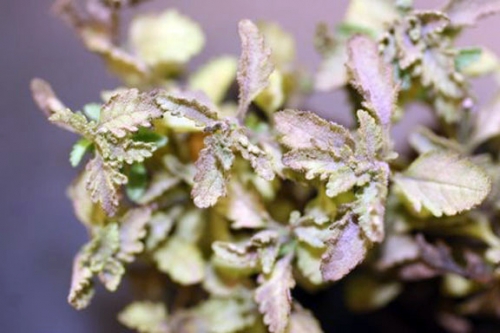Downy and powdery mildews showing up now
Editor’s note: This article is from the archives of the MSU Crop Advisory Team Alerts. Check the label of any pesticide referenced to ensure your use is included.
Editor’s note: This article is from the archives of the MSU Crop Advisory Team Alerts. Check the label of any pesticide referenced to ensure your use is included.
Greenhouse growers need to pay attention to a couple of mildews that are occurring in area greenhouses. Downy mildew has shown up on Jamesbrittania cultivars. Look for the greyish/purplish fuzz on the undersides of the leaves. Plants in question may show a slight yellowing on the upper leaf surface.

Photo 1. Downy mildew.
Downy mildew can be explosive when the weather is wet and humid. The downy mildew pathogen requires free moisture from condensation or watering on the plant surface to germinate. Limit disease by venting, reducing the time that leaves are wet (fewer than six hours) and keeping relative humidity to a minimum (less than 85 percent). Downy mildew has a unique thick-walled survival structure that allows it to persist in soil, growing media or diseased plants for years. If downy mildew is found, dispose of all diseased plants immediately. Place the entire plant, including the growing media and pot, in a bag and promptly seal it. Do not carry diseased plants through the greenhouse for disposal because spores on the infected plants will be released and may infect nearby healthy plants of the same plant type. Disposing of diseased plants removes a source of spores that would otherwise allow the downy mildew to spread.
Powdery mildew is being observed on Torenia and Non-Stop Begonias at this time. Look for the whitish flour like dust on the leaves. Powdery mildew, unlike many foliar diseases, does not need free moisture on the leaf to thrive. Favorable environmental conditions include high relative humidity (greater than 95 percent), moderate temperatures of between 68oF to 86o F and relatively low light levels. Infections may be more common in the spring and fall when changes between the day and night temperatures encourage high relative humidity levels, especially at night. Spores (conidia) are produced in chains. Air currents and water splash in the greenhouse easily move these spores. The spores germinate and thread-like strands (hyphae) grow along the leaf tissue. Powdery mildews obtain plant nutrients by sending feeding organs (haustoria) into the epidermis. Once a spore lands on a plant, it may take as little as three days but more often five to seven days for infection to develop.
In both cases intensive fungicide programs are essential. The following recommendations are from Dr. Mary Hausbeck, MSU Plant Pathology.
Downy mildew
Control by using a Subdue MAXX drench once followed by sprays of :
1. Heritage 50WDG plus mancozeb
2. Stature DM 50WP plus mancozeb
3. FenStop plus Mancozeb
Repeat foliar sprays beginning with 1.
Powdery mildew
Heavy disease pressure-treat with a rotation of: Eagle followed by Terraguard 50W.
Light disease pressure-treat with a rotation of: Heritage, Insignia, Strike and then Compass.



 Print
Print Email
Email




